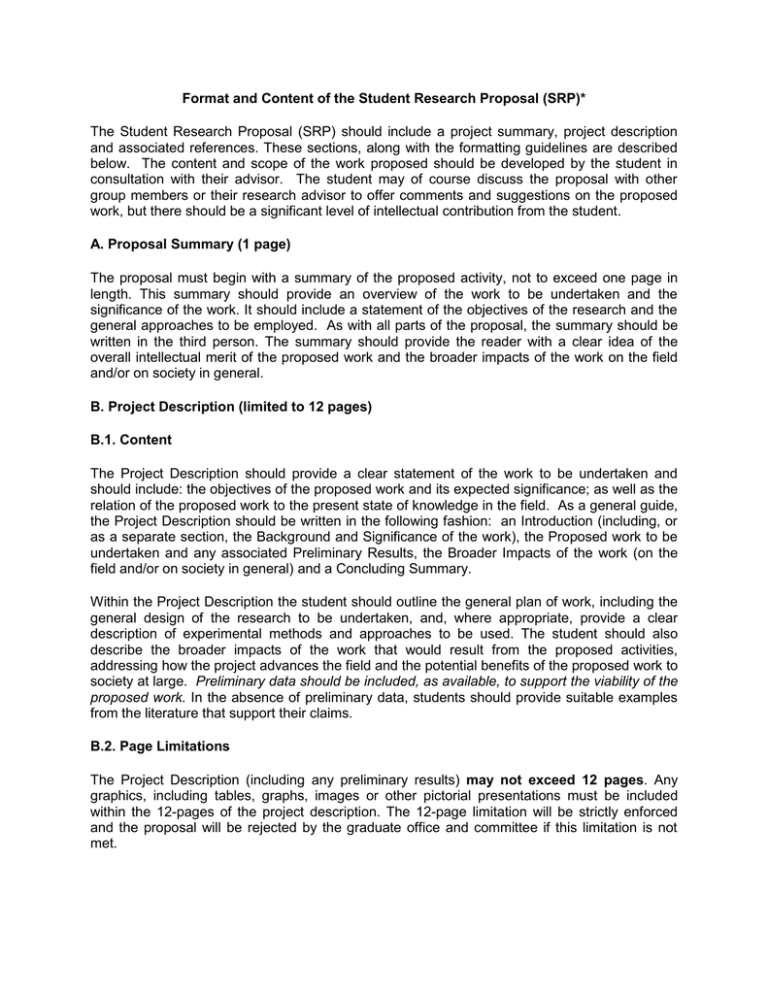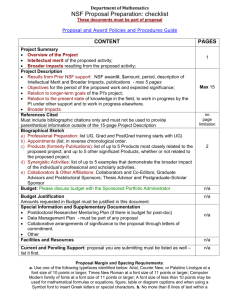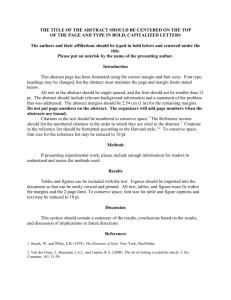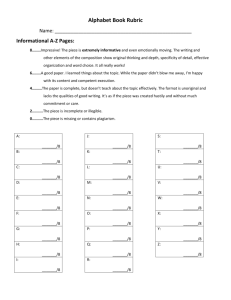Format and Content of the Student Research Proposal (SRP)*
advertisement

Format and Content of the Student Research Proposal (SRP)* The Student Research Proposal (SRP) should include a project summary, project description and associated references. These sections, along with the formatting guidelines are described below. The content and scope of the work proposed should be developed by the student in consultation with their advisor. The student may of course discuss the proposal with other group members or their research advisor to offer comments and suggestions on the proposed work, but there should be a significant level of intellectual contribution from the student. A. Proposal Summary (1 page) The proposal must begin with a summary of the proposed activity, not to exceed one page in length. This summary should provide an overview of the work to be undertaken and the significance of the work. It should include a statement of the objectives of the research and the general approaches to be employed. As with all parts of the proposal, the summary should be written in the third person. The summary should provide the reader with a clear idea of the overall intellectual merit of the proposed work and the broader impacts of the work on the field and/or on society in general. B. Project Description (limited to 12 pages) B.1. Content The Project Description should provide a clear statement of the work to be undertaken and should include: the objectives of the proposed work and its expected significance; as well as the relation of the proposed work to the present state of knowledge in the field. As a general guide, the Project Description should be written in the following fashion: an Introduction (including, or as a separate section, the Background and Significance of the work), the Proposed work to be undertaken and any associated Preliminary Results, the Broader Impacts of the work (on the field and/or on society in general) and a Concluding Summary. Within the Project Description the student should outline the general plan of work, including the general design of the research to be undertaken, and, where appropriate, provide a clear description of experimental methods and approaches to be used. The student should also describe the broader impacts of the work that would result from the proposed activities, addressing how the project advances the field and the potential benefits of the proposed work to society at large. Preliminary data should be included, as available, to support the viability of the proposed work. In the absence of preliminary data, students should provide suitable examples from the literature that support their claims. B.2. Page Limitations The Project Description (including any preliminary results) may not exceed 12 pages. Any graphics, including tables, graphs, images or other pictorial presentations must be included within the 12-pages of the project description. The 12-page limitation will be strictly enforced and the proposal will be rejected by the graduate office and committee if this limitation is not met. C. References All applicable references should be provided to appropriately cite the work outlined in the proposal. References should be included using a number scheme rather than by author name and year. References must be all inclusive, and contain the names of all authors, the article and journal title, book title, volume number, inclusive page numbers, and year of publication. Students must be especially careful to follow accepted scholarly practices in providing citations for source materials relied upon when preparing any section of the proposal. While there is no limitation for the number of references, this includes bibliographic citations only and must not be used to provide additional information or commentary on the work or procedures being used. Directing the reader to URLs that provide information related to the proposal may not be used. Proper citations of web data or sites must be given using standard practices of listing the full address and last access date. e.g. http://www.chem.tamu.edu (last accessed 06/25/2013). 2. Proposal Formatting Requirements All sections of the proposal, including references, must conform to the following guidelines. a. Use one of the following typefaces identified below: Arial, Courier New, Palatino Linotype, Times or Times New Roman at a font size of no less than 11 point. NOTE: Font sizes down to 9 point may be used for mathematical formulas or equations, figure, table, scheme or diagram captions and when using a Symbol font to insert Greek letters or special characters. b. All text must be no less than single spaced. c. All page margins must be at least one inch in all directions. The documents must be prepared using only a standard, single-column format for the text. Double column formats are not permitted. The guidelines specified above establish the minimum type size requirements; however, students are advised that readability is of paramount importance and should take precedence in selection of an appropriate font for use in the proposal. Unreadable proposals may be rejected by their committee. *These guidelines are based on, and modified from, the Grant Proposal Guidelines of the National Science Foundation and the National Institutes of Health with the aim of providing the student with a snapshot of how real proposals to federal funding agencies are prepared. Students may view these guidelines in detail at: www.nsf.gov - see Grants Proposal Guidelines Section 2b-f http://www.nsf.gov/pubs/policydocs/pappguide/nsf11001/gpg_index.jsp http://grants.nih.gov/grants/writing_application.htm (especially useful are guidelines for writing Research Design and Methods (Approach), Innovation and Significance)




